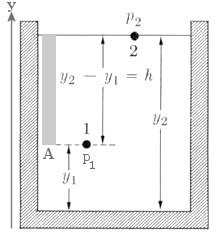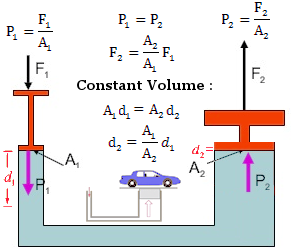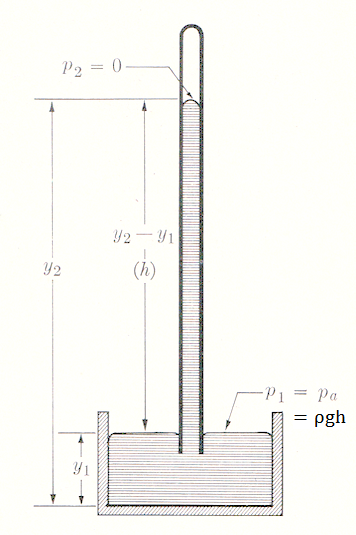

dp = -
 g dy ---------- (24).
g dy ---------- (24).Taking point 1 and 2 as shown in Figure 18, integration of
Eq.(24) yields:
p2 - p1 = -
 g (y2 - y1) ---------- (25)
g (y2 - y1) ---------- (25)
| Home Page | Overview | Site Map | Index | Appendix | Illustration | About | Contact | Update | FAQ |
 |
 |
The term "hydrostatics" is applied to the study of fluids at rest, including both liquids and gases. For this special case, u = 0 in the Navier-Stokes equations, the external force F = -g (in the negative y direction) and the pressure gradient is just dp. Eq.(2) is reduced to the simple form: dp = -  g dy ---------- (24). g dy ---------- (24).Taking point 1 and 2 as shown in Figure 18, integration of Eq.(24) yields: p2 - p1 = -  g (y2 - y1) ---------- (25) g (y2 - y1) ---------- (25)
|
Figure 18 Hydrostatics |
Figure 19 Pressure, Atmospheric |
which shows that the pressure is less in higher elevation as it is well known in the Earth's atmosphere (Figure 19). |
 Vg ---------- (26)
Vg ---------- (26) Vg is smaller or greater than the buoyant force.
Vg is smaller or greater than the buoyant force. |
Submarine controls the submerging and surfacing by admitting water into a tank or pumping it out. When the submarine is on the surface its ballast tanks are full of air (Figure 20a). The air inside the hull brings the average density of the entire ship below the density of saltwater. Because the sub is less dense, it floats. The average density of a submerging submarine is increased by flooding the ballast tanks with water through flood ports on the bottom of the tanks with the release of air out of the top of the tanks (Figure 20a). Once the overall density of the submarine is equal to the water around it, it has the neutral buoyancy and will remain at that depth. High pressure air is blown into the ballast tanks to push the water out when the submarine is prepared to surface again. |
Figure 20a Submarine |
Air does not provide a lot of buoyant force because its density is about 1000 times lower. Only balloon filled with low density gas such as hydrogen or helium can rise up to the sky. |
 |
 |
The principle of hydraulic press operation follows the same rule prescribed by Eq.(25) with  g (y2 - y1) << p1, p2 so that p1 g (y2 - y1) << p1, p2 so that p1  p2 as illustrated in Figure (20b), which shows that a smaller force F1 applied to a piston of smaller cross section A1 can exert a large force F2 of proportionally larger A2. The ideal mechanical advantage is A2/A1. Barber chaits, dentist chaits, car lifts, and hydraulic brakes are all devices that make use of this principle. Since volume is constant for incompressible fluid, i.e., A1d1 = A2d2, thus, the column height d2 = (A1/A2)d1 is smaller on the lifting side than d1 on the pressing side. p2 as illustrated in Figure (20b), which shows that a smaller force F1 applied to a piston of smaller cross section A1 can exert a large force F2 of proportionally larger A2. The ideal mechanical advantage is A2/A1. Barber chaits, dentist chaits, car lifts, and hydraulic brakes are all devices that make use of this principle. Since volume is constant for incompressible fluid, i.e., A1d1 = A2d2, thus, the column height d2 = (A1/A2)d1 is smaller on the lifting side than d1 on the pressing side.
|
Figure 20b Hydraulic Press [view large image] |
Figure 20c Barometer |
Another application of Eq.(25) is to make barometer for which p2  0 at the closed end of the tube while p1 = 0 at the closed end of the tube while p1 =  gh is now equal to the atmospheric pressure pa , which is proportional to the column height h since gh is now equal to the atmospheric pressure pa , which is proportional to the column height h since  and g are constants (Figure 20c). and g are constants (Figure 20c). |